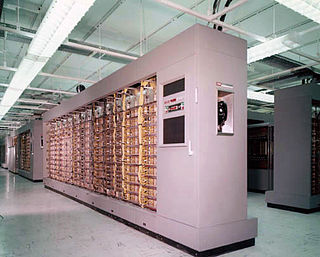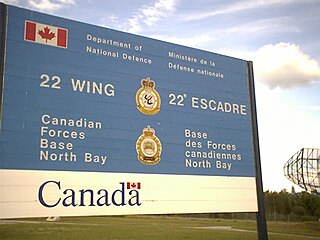
The Semi-Automatic Ground Environment (SAGE) was a system of large computers and associated networking equipment that coordinated data from many radar sites and processed it to produce a single unified image of the airspace over a wide area. SAGE directed and controlled the NORAD response to a possible Soviet air attack, operating in this role from the late 1950s into the 1980s. Its enormous computers and huge displays remain a part of cold war lore, and after decommissioning were common props in movies such as Dr. Strangelove and Colossus, and on science fiction TV series such as The Time Tunnel.

Whirlwind I was a Cold War-era vacuum tube computer developed by the MIT Servomechanisms Laboratory for the U.S. Navy. Operational in 1951, it was among the first digital electronic computers that operated in real-time for output, and the first that was not simply an electronic replacement of older mechanical systems.

The MIT Lincoln Laboratory, located in Lexington, Massachusetts, is a United States Department of Defense federally funded research and development center chartered to apply advanced technology to problems of national security. Research and development activities focus on long-term technology development as well as rapid system prototyping and demonstration. Its core competencies are in sensors, integrated sensing, signal processing for information extraction, decision-making support, and communications. These efforts are aligned within ten mission areas. The laboratory also maintains several field sites around the world.

The AN/FSQ-7 Combat Direction Central, referred to as the Q7 for short, was a computerized air defence command and control system. It was used by the United States Air Force for ground-controlled interception as part of the Semi-Automatic Ground Environment network during the Cold War.

The Southeast Air Defense Sector (SEADS), was a unit of the US Air Force located at Tyndall Air Force Base near Panama City, Florida. It provided air defense and surveillance of the southeastern region of the US. SEADS closed in winter 2005, giving up surveillance and control of their airspace to the Eastern Air Defense Sector (EADS) and the former Northeast Air Defense Sector (NEADS).

The AN/FSQ-32 SAGE Solid State Computer was a planned military computer of the United States Air Force. It was central for deployment to Super Combat Centers in nuclear bunkers and to some above-ground military installations. In 1958, Air Defense Command planned to acquire 13 Q-32 centrals for several Air Divisions/Sectors.

North Truro Air Force Station (AFS) is a closed United States Air Force General Surveillance Radar station. It is located 2.2 mi (3.5 km) east of North Truro, Massachusetts.

The Washington Air Defense Sector (WaADS) is an inactive United States Air Force organization. Its last assignment was with the Air Defense Command (ADC) 26th Air Division, being stationed at Fort Lee Air Force Station (AFS), Virginia. It was inactivated on 1 April 1966.

The Syracuse Air Defense Sector (SADS) is an inactive United States Air Force organization. Its last assignment was with the Air Defense Command (ADC) 26th Air Division at Hancock Field, New York.

The Chicago Air Defense Sector (CADS) is an inactive United States Air Force organization. Its last assignment was with the Air Defense Command (ADC) 30th Air Division at Truax Field Wisconsin. It was inactivated on 1 April 1966.

Ground Equipment Facility QRC is an FAA radar station that was part of a Cold War SAGE radar station for aircraft control and warning "from Massachusetts to southern Virginia, and as far out to sea as possible." Benton AFS was also the first operational "regional data processing center" for the GE 477L Nuclear Detection and Reporting System.
The SAGE radar stations of Air Defense Command were the military installations operated by USAF squadrons using the first automated air defense environment and networked by the SAGE System, a computer network. Most of the radar stations used the Burroughs AN/FST-2 Coordinate Data Transmitting Set (CDTS) to automate the operator environment and provide radar tracks to sector command posts at SAGE Direction Centers (DCs), e.g., the Malmstrom Z-124 radar station was co-located with DC-20. The sector/division radar stations were networked by DCs and Manual Control Centers to provide command, control, and coordination for ground-controlled interception of enemy aircraft by interceptors such as the F-106 developed to work with the SAGE System.

The 4620th Air Defense Wing is a discontinued wing of the United States Air Force. Its last assignment was with Air Defense Command (ADC) at Santa Monica, California, where it was discontinued in 1961. The wing was organized in 1955 to ensure that the Semi-Automatic Ground Environment (SAGE) air defense system, was compatible with ADC's operational requirements. It also performed operational testing and training on SAGE and earlier systems. Once SAGE started to become operational, the need for the wing no longer existed and it was discontinued, although one of its subordinate groups continued the SAGE training mission until 1962.
Backup Interceptor Control was the Electronic Systems Division 416M System to backup the SAGE 416L System in the United States and Canada. BUIC deployed Cold War command, control, and coordination systems to SAGE radar stations to create dispersed NORAD Control Centers.

The Fort Heath radar station was a USAF radar site and US Army Missile Master installation of the joint-use site system (JUSS) for North American Air Defense at a former coastal defense site. The Cold War radar station had 2 USAF AN/FPS-6B height finding radars, 2 Army AN/FPS-6A height finders, an FAA ARSR-1 radar emplaced 1958-9, and an Army nuclear bunker. Arctic Towers were the pedestals for the FPS antennas and radomes, while the Air Route Surveillance Radar was on a 50-foot extension temperate tower adjacent to the Federal Aviation Administration building.
The GE AN/GPA-37 Course Directing Group was a USAF Cold War air defense command, control, and coordination system for weapons direction. During Air Defense Command's "Control Capability Improvement Program" to improve command guidance of manned aircraft, the AN/GPA-37 was "developed by the General Electric Heavy Military Electronic Equipment Department at Syracuse in conjunction with...Rome Air Development Center and the Electronics Research Laboratories of Columbia University." Used to process radar data, the system was to "track a potential enemy aircraft and direct intercepters [sic] into a position from which they can make their automatic firing runs", the system included the:
The GE AN/GPA-73 Radar Course Directing Group was an air defense command, control, and coordination system of the United States Air Force. It was developed for the Electronic Systems Division 412L Air Weapons Control System for weapons direction. The AN/GPA-73 was used to create a "Base Air Defense Ground Environment", for which Air Defense Command had recommended the system as "SAGE back-up control of BOMARC" in June 1958. When the GPA-73 was emplaced with the AN/FSA-21 Weapons Control Group computer for GCI, the system created a "miniature SAGE" military installation. The GPA-73 could also direct Project Nike surface-to-air missile fire from Nike Integrated Fire Control sites equipped with the "412 Target Designation System" in the Battery Control Van in a space allocated by February 1957 "behind the Acquition Operator [sic]". and the AN/GPA-73.

The ITT 465L Strategic Air Command Control System was a Cold War "Big L" network of computer and communication systems for command and control of Strategic Air Command "combat aircraft, refueling tankers, [and] ballistic missiles". International Telephone and Telegraph was the prime contractor for Project 465, and SACCS had "Cross Tell Links" between command posts at Offutt AFB, March AFB, & Barksdale AFB (SACCS also communicated with the Cheyenne Mountain Complex and Air Force command posts. The 465L System included IBM AN/FSQ-31 SAC Data Processing Systems, Remote and Simplex Remote Communication Systems, SAC Network Control Office, "4-wire, Schedule 4, Type 4B alternate voice-data operation", and one-way communication with "ICBM launch control centers" In addition to IBM for the "Super SAGE type computers", another of the 6 direct subcontractors was AT&T,

A radar tower is a tower whose function is to support a radar facility, usually a local airport surveillance radar, and hence often at or in the vicinity of an airport or a military air base. The antenna is often continually rotating. In addition, radar towers are used for the installation and operation of search and height finder radars at military radar stations, where the mission is to support air defense missions. These missions were characterized as Aircraft Control & Warning (AC&W), or Long Range Surveillance in support of the Semi-Automatic Ground Environment (SAGE).
C. Robert Wieser qualified from MIT as an electrical engineer and later became a developer of electrical and computing technology. He was especially and particularly noted for having contributed to the development of the Cape Cod Air Defense system and SAGE system.












